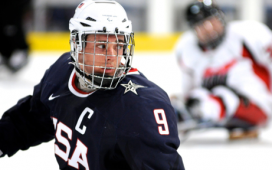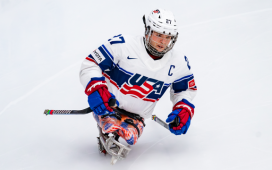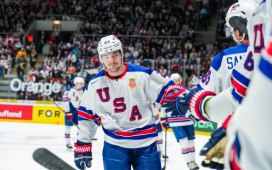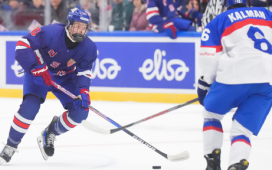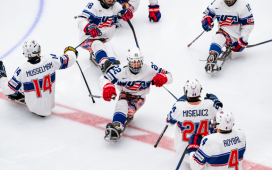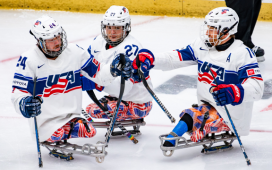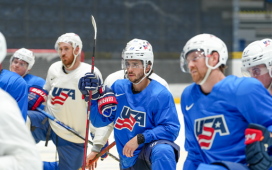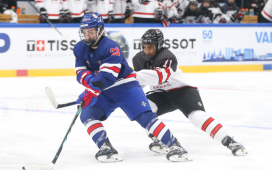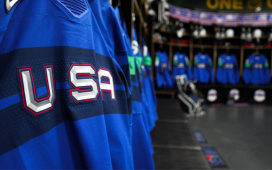Good to be back, folks. It’s the first Ask Me Anything Mailbag in a while, and I received so many juicy questions that it hurt to only pick five. Sorry! Since we’re enduring the closest thing to a “dead period” on the hockey calendar, we have an heterogeneous hodgepodge of interesting topics to tackle.
The Illustrious TJB (@1ILLUSTRIOUS) asks…
Who gets to the Hall of Fame first: Curtis Joseph, Chris Osgood or Daniel Alfredsson?
This may sound backward, but I think the guy who has been eligible the shortest amount of time has the best shot. Circumstantially, we know Joseph and Osgood have qualified since 2012 and 2013, respectively, whereas Alfredsson has only been eligible since 2017. We already know CuJo and Osgood aren’t popular picks among the selection committee, whereas we can’t say that for certain with Alfredsson yet.
That’s a guess based on a bit of deductive reasoning. But if we break down the hockey element of things, ‘Alfie’ likely still has the edge. He won the Calder Trophy in 1995-96, racked up more than 1,100 points and was the Ottawa Senators’ longest-serving captain. He played his prime years during the Dead Puck Era but still consistently hovered around point-per-game production. During his most productive 10-season stretch, from 1999-00 through 2009-10, he quietly had the third-most points of any NHLer, trailing only Joe Thornton and Jarome Iginla. That doesn’t account for newly dominant players such as Alex Ovechkin and Sidney Crosby bursting onto the scene halfway through that stretch, of course, but it speaks to Alfredsson’s consistency.
Joseph has a decent case to beat Alfredsson to the Hall. Joseph’s 454 wins rank fifth all-time, and he finished top-five in Vezina voting five times. He earned fame for his tremendous playoff efforts as an Edmonton Oiler and his high-profile work with the Toronto Maple Leafs, but Joseph was ridiculously underrated earlier in his career as a St. Louis Blue, stopping more pucks than any goalie in the league three straight seasons from 1991-92 to 1993-94. Still, he was never even named a second-team all-star and was overshadowed during a superstar goalie era that included Patrick Roy, Dominik Hasek, Ed Belfour and Martin Brodeur.
Osgood has the weakest case of the three. He was a dependable caretaker goaltender on a collection of powerhouse Detroit Red Wing teams that were peppered with Hall of Famers. He didn’t receive a single Vezina vote in 13 of his 17 seasons. It’s fair to call him underrated, as he posted some outstanding numbers during his best years with Detroit, but it was also the equivalent of piling up home runs during the steroid era. Many goalies had ridiculous numbers during the Dead Puck years, so Osgood’s stats stand out less when you juxtapose them with those of his peers. He was a good goalie but, even at his best, he was closer to top-10 in the league than top-five.
If I had my way, I’m not sure I’d put any of these guys in the Hall. I think the Hockey Hall of Fame is too lenient and should be reserved for players who were considered among the most dominant at their positions for half a decade or more. That’s why I prefer seeing a shooting-star career like Eric Lindros’ earn Hall recognition than someone who was merely “quite good for a long time.”
Also, concerning Joseph and Osgood, there’s another goalie who deserves a nod before they do. He has a Calder, a Vezina, two Stanley Cups,and three all-star selections (a first and two seconds). That’s Tom Barrasso, who, let’s face it, is only outside the Hall because of his chilly relationship with the hockey media.
Paul Kent (@paulskent58) asks…
Lots of discussion on racism in hockey lately. To me it seems like players and fans are held to a much higher standard of conduct than NHL TV personalities. What responsibility do you feel NHL partners (broadcasters/owners) have in airing talent that believes diversity is good?
Great question, Paul. I think the NHL partners should be heavily responsible for airing talent that supports diversity. In addition to simply being, morally, the right choice, doing anything to the contrary would contradict recent efforts by the league to brand itself as a more inclusive entity, from the Hockey is For Everyone campaign to the hiring of Kim Davis as executive vice-president of social impact, growth initiatives and legislative affairs.
And if I’m being honest, I still do see a double standard when it comes analyzing and especially criticizing players with ethnically diverse backgrounds. It does seem like black players are singled out for their personality traits, fashion choices and dressing-room interactions far more often than white players are. Every time I think about that, I’m reminded of a candid conversation I had with Evander Kane two seasons ago when I visited him in Buffalo for an interview. He opened my eyes with this story when we were discussing racism and his treatment a few years earlier after he posted photos on social media holding a stack of bills in Vegas, using it as a pretend phone:
“Something outside of the rink, like me holding stacks of cash in Vegas, was just me having a fun time, trying to give a little insight as to what I’m doing when hockey isn’t even going on,” Kane said in fall 2017. “You’ve got guys like (now-retired wide receiver) Wes Welker throwing money in the air at the Kentucky Derby, $100 bills. He plays in the NFL, and it’s just another day in the life. For me, being a Canadian hockey player in a Canadian market, it was looked at as a selfish, poor thing to do.”
Not only does the NHL suppress personality more than a league like the NFL does, the Welker example showed a distinct difference in treatment toward two athletes with different skin colors doing something similar. So to return to your question, it’s never healthy when broadcasters perpetuate the stereotype of non-white players being “selfish” or “divas.” I thus believe it would be prudent for NHL rightsholders to hold their analysts accountable if they’re saying things that put down diversity.
Non Alcoholic Beer Leaguer (@Angrypunishment) asks…
Who is most likely to sign Braden Holtby once he’s finished with the Washington Capitals?
The wording of this question implies Holtby’s days with the Capitals are numbered, and I agree with that sentiment for reasons I outlined earlier this week.
So, for the sake of this answer, let’s accept that Holtby goes to market next summer. The natural contract comparable, assuming Holtby’s 2019-20 is healthy and reasonably effective, will be Sergei Bobrovsky’s seven-year, $70-million contract, signed this summer. Holtby will be the same age in July 2020 that Bobrovsky is now, and Holtby’s Vezina Trophy and Stanley Cup ring measure up to Bobrovsky’s two Vezinas pretty well.
The ideal suitors for Holtby (a) must have the cap space, naturally; (b) must have a goaltending vacancy in summer 2020; and (c) should be a contender or at least have potential to become one, as a true rebuilding squad wouldn’t want to sign a veteran for seven years of his 30s.
Plenty of teams qualify as Holtby suitors based on cap space, so let’s narrow it down further by factoring in the projected vacancies. The Chicago Blackhawks may have their long-term No. 1 in Robin Lehner, depending on how he fares this season, but he’s on a one-year deal, and Corey Crawford has one season left on his contract. Right now, then, the Hawks have a potential vacancy. They’d be a team to watch. The Carolina Hurricanes technically have Petr Mrazek and James Reimer signed for two more seasons each but, considering they only combine for $6.525 million in cap space, I don’t think we can rule Carolina out as a suitor, especially as a team positioned to contend for a while.
For me, one team flashes in neon lights as best bet to sign Holtby: the Calgary Flames. They currently have just one NHL goaltender under contract for 2020-21: David Rittich at $2.75 million. The Flames have matured into a contender with a blend of young and veteran talent that should make them a win-now team for several years. They still have $28.46 million in cap space for next year, not factoring in any potential increase in the cap, so even RFA Matthew Tkachuk’s new contract will leave plenty of money for Holtby. As a kicker: Holtby hails from a family farm in Lloydminster, Sask. The Flames are, geographically, the second-closest NHL team to his hometown after Edmonton. Calgary could not be a better fit, for so many reasons.
Grapes Dictionary (@MCMI_1901) asks…
Do you think the David Pastrnak contract is playing into the current lack of RFA signings?
Yes. Sort of. As in, Pastrnak’s six-year deal with a $6.67-milion AAV is the type of contract we may not see RFAs sign anymore. His is merely one example. Another: John Tavares’ six-year contract coming off his entry-level deal, which made him criminally underpaid at just $5.5 million a year.
To me, the two main culprits are Nathan MacKinnon’s seven-year pact ($6.3 million AAV) and Mark Scheifele’s eight-year deal ($6.13-million AAV), which were announced the same day: July 8, 2016. MacKinnon is arguably worth double his current salary, while Scheifele is a $10-million player. The logic was perfectly acceptable at the time: young player gets term and stability. On the GM side, the benefit was even greater: offer young player big raise knowing the price will still end up being a massive discount, maintain control over player for as many years as possible.
But players are starting to wake up. On the enlightened side, we have Nikita Kucherov. Coming off his entry-level deal, he signed a three-year bridge that helped the Lightning sort out their cap woes – but also made Kucherov an RFA again just in time for him to reach the beginning of his prime-year stardom. That helped him score an eight-year contract with a $9.5-million AAV and, because it starts in his age-26 season, he’ll go UFA by 34 and will still, health permitting, be young enough to score another big, multi-year pact.
When we saw Auston Matthews sign a shorter extension than expected with the Leafs, I wondered immediately if he was influenced by the Kucherov camp’s philosophy. It’s not exactly the same situation, as Matthews’ deal is five years and takes him to unrestricted free agency, but the principle is the same: finish your second contract when you’re still young, and you’ll end up with two star-level paydays in your career. It’s even truer for Matthews because he broke into the league as a teenager.
I don’t think it’s a coincidence that, following Matthews’ contract, we’re seeing so many RFAs drag out their talks. Players and their agents are also likely holding their breath to see how the next U.S. TV deal, beginning for 2021-22, affects the cap, as it could open up possibilities for bigger contracts. If you’re locked up for too long, you’ll miss the chance to reap the rewards.
mmarkwell (mmarkwell asks)…
What is it that lets certain players get into the NHL and make a career out of it even though they may not be the best players even at their depth position?
I love this question, as it comes up a lot when we talk to coaches, GMs and scouts about players who are on the cusp of reaching the NHL. I’ll give you a case study that helps illuminate the answer.
Last season, as part of our annual Future Watch special magazine, I was working on a story about the Toronto Maple Leafs’ prospect crop. I went to the Marlies’ practice to speak with their coach, Sheldon Keefe. We ran through a list of the Leafs’ 10 best prospects, and for each, he’d provide a mini scouting report, describing their progress and NHL readiness.
Jeremy Bracco created the most interesting conversation. In terms of raw talent, he was the Marlies’ star last season. His 79 points were 14 more than any other player on the team and placed him second in AHL scoring. He’s a shifty, creative offensive weapon. Why, then, was he watching the likes of Trevor Moore get called up to the Leafs before him? Why weren’t the Leafs taking a chance on Bracco’s upside over, say, a veteran like Tyler Ennis?
The reason, as Keefe explained, was that Bracco’s skill set only suited him for top-six duty.
“I think he is, right now, the type of player that is a power-play specialist, that when the opportunity presents itself, he’s going to make a good offensive play,” Keefe said last winter. “We’re working to make his game more well-rounded so that he is able to be more versatile, play in all situations, and we’ve seen good progress there. He shows up in a lot of positive defensive situations, more so than a year ago, for sure. But we want him to continue to grow in those areas so that he is more versatile.”
Bracco’s puck skills are NHL ready but, if his all-offense game means he’s only usable as a top-six forward, he can’t make the Leafs, who have a loaded top six. That’s the main reason we sometimes see heart-and-soul guys earn promotions before higher-ceiling guys. Being malleable, able to kill penalties and function on any forward line or any type of defense-pair assignment, is what endears you to an NHL coach. Of course, in today’s game, even if you’re a grinder, you have to do it with speed.
Want more in-depth features, analysis and an All-Access pass to the latest content? Subscribe to The Hockey News magazine.
